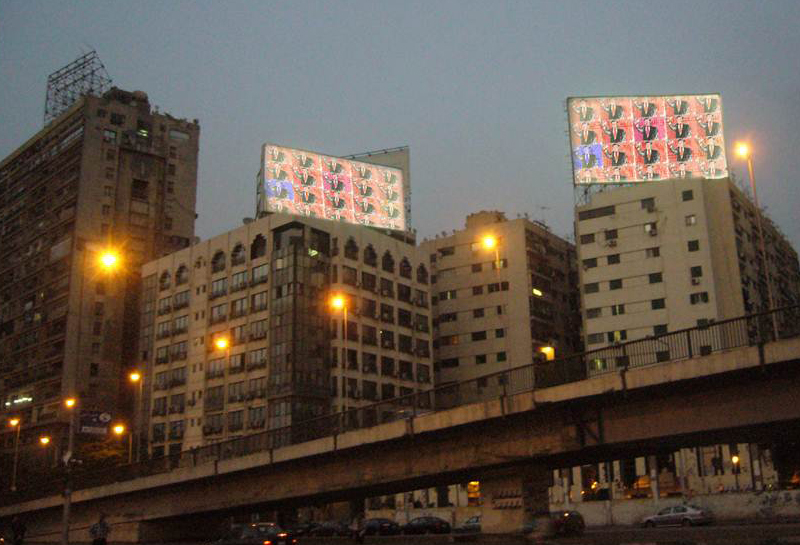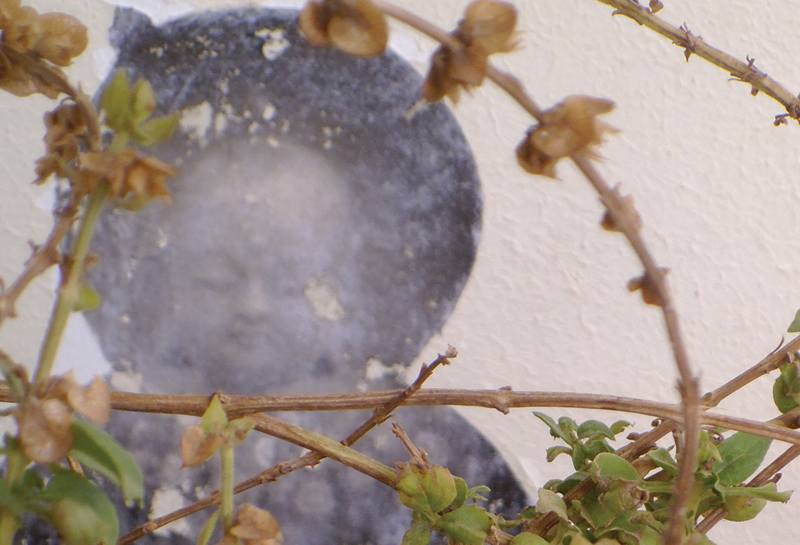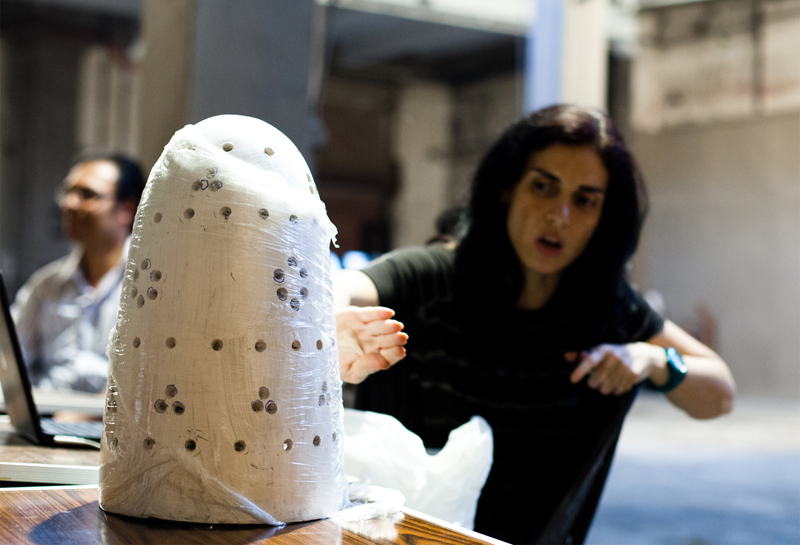Public Space: Cairo
collaborative public art workshops + proposals conducted at Townhouse Gallery in Cairo, EgyptApril–June 2012
Public Space: Cairo was a collaborative, workshop-based project that explored the possibilities for engaging with art and design in public spaces. Taking advantage of an exploratory time when public space in Cairo has now been radically reconsidered, we worked with workshop participants and members of their communities to explore their ideas of what impactful public art might look like in Cairo today.
Working with the renowned Townhouse Gallery in downtown Cairo in Spring 2012, this project consisted of a four-week intensive series of free workshops focused on process and skill-building and a final public presentation and lecture. We worked with participants to investigate how public art can impact society, what kinds of public art are happening in Egypt and around the world, and worked with them to create their own projects and campaigns. The process included talking with local artists and designers; talking with community members about how art impacts them and their surroundings; creating and installing new public works; and designing polished proposals to present to stakeholders, neighborhoods, and potential funders. Technical workshops were paired with critiques and discussion, with a focus on how art and design are effective in public spaces and what context means in communities.
We did not dictate what the outcomes or possibilities for public art are, but rather, through sharing, learning, and creating ideas on how public art could be the most effective, made space for criticality of contemporary public art in Cairo and autonomy to discover the new trajectory post-revolution. The workshops aimed to support young artists and practioners in their work, and provided a focused, critical space for dialogue on public art and process.
The workshops were held over four and a half weeks, each with a wide guiding lens and/or technique: Graphic Design, Performance & Theater, Urban Interventions, and Graffiti & Street Art. We held three sessions per week at three hours each of presentations, research, art and design history, guest artists and mini-workshops, critical discussions on Egyptian visual culture and public art, time for creation, brainstorming, critiques, proposal writing, and time spent in community.
We explored how artists, collectives, and communities have used art and design for political and social change all over the world, looking at everyone from Ai Weiwei to the Yes Men to JR and Swoon. We looked at people working worldwide and people working in Egypt with equal scrutiny. The interesting questions came when they started to look at the history of Egyptian politics and public art, both past and present, asking questions like, Where did we come from? Where are we now? Where do we want to go from here? They questioned themselves and their own motives in their work, they asked incredible questions about what it means to be an artist that uses public space as their canvas and what it means to be responsible to a public or many.
During the four and a half weeks, the participating artists developed project proposals, models, mockups, and budgets. More than half created completed works from start to finish, putting them in public and documenting reactions. Others continued to develop their projects long after the workshops ended and into the summer, experimenting with feedback from the group.
The public presentations rounded out Public Space: Cairo and invited the public to engage with the participants, their work and ideas. Some presented documentation of their work in public, some presented models, and some ideas from their proposals. The artists appreciated having time to engage a public audience in debates, open critiques, and question-and-answer sessions, and some even took this experience back with them to continue work on their projects and proposals.
ABOUT PUBLIC SPACE: CAIRO
Concept/Workshop Leaders
Jenna Crowder
Keith Lane
Participating Artists
Amado AlFadni *
Abdulrahim Abdulkarim *
Enas Abo Alkomsan *
Habeeba Sultan *
Karim Abdo *
Maie Abou Seeda
Mamdouh Kassifi *
Mario Mohsen
Mona Rizk
Nihal Ragab
Nihal Wahby *
Omneia Naguib *
Rania Fouad *
Salma Belal
Sherif Makki
Waleed Farog
Yahya Mekkawi
* Public Presentation Artists
Workshop Assistants
Mina Noshy
Alaina Dyne
Workshop Guest Artists
Bassem Yousri
Mahatat for Contemporary Art
Astrid Thews
Mayada Said
Partners
Townhouse Gallery & William Wells
SAWA Workshops
Gallery Liaison
Ania Szremski
Public Presentation Coordinator
Dina Kafafi
Photographer
Keith Lane
Videographers
25TV
Tarek Atia
Seif Kirfan
Funding
Generous backers on Kickstarter: 229 Collective, Professor Ahmed Amer, Adam Burk, Adam Williams, Alaina Dyne, Alex Cook, Alex Stonehill, Allison J. Rose, Allyson & Andrew Spires, Amy Lust, Andrea Smith, Andy Stocking, Anne Sleeman, Anthony Laney, Ashley Hansen, Awer G. Bul, Aziz Yazdani, Barbara & Jerry Daley, Becky Conrad, Benjamin Chernivsky, Benjamin Owen, Bill & Christine Bradstreet, Bill Bramble, Cameron & Kara Chisholm, Caroline Dobuzinskis, Carolyn Block, Carolyn & Dan Hopper, Carrie & Phil McGowan, Carrie Scanga, Christina Bechstein, Christopher Chen, Claire Beeuwkes, Colleen Erin Cole, Crystal Heiden, D.Billy, David Y. Lee, Dawn Benedetto, Donald Tuski, Elizabeth Dranitzke, Eric Damon Walters, Erica Moen, Hilary Palanza, Ingrid Spanjaard, James Campbell, Japhet Els, Jeff Badger, Jen Girdish, Jennifer Graham, Jenny Markley, Jessica Lane, Jim Darling, Joe Callahan, John Stinson, Jon Wye, Julia Marden, Kamren Charpentier, Karen & Jeff Tingey, Kate Vlach, Katie Fielding, Kaveh Haerian, Kelley McRae, Ken Brickman, Kesra Hoffman, Kira Wisniewski, Kyle DiMare, Larissa Leclair, Laura Hahn, Laura Kaufer, Lisa van Oosterum, Mark Manausa, Mary Miller, MaryAnn & Cliff, Matt Dunn, Matthew Kleinrock, Merilee McFarland, Michael Andrade, Michael Phelan, Miranda Ash, Mitchell West, Molly Danner, Nick Magel, Nick Martin, Noe Todorovich, The Nupp Family, Patrick Moran, Patrick Onofre, Peggy McKendry, Peter Kane, Regin Igloria, Ron & Terri Crowder, Ruth Morse, Samantha May, Sarah Dougherty, Sean Connell, Susan Johnson, Tim Foley, Tom Rall, Victor Acquah, Victoria Milko, William Bert & Call+Response
 Amado AlFadni, If I Were President
Amado AlFadni, If I Were President“Since the beginning of the Egyptian revolution, I have been using my work to react. The revolution was made by the public, so I wanted to do work made with the public instead of just about them. The idea for If I Were President came from the presidential campaign posters that started taking over all of the public spaces in the city. The posters might have slogans or huge pictures of the candidate, but there was no space for dialog with the public. This one-sided relationship, in which the candidate makes a promise the people — “Freedom,” “Justice,” “In God’s Name,” — without explaining how to achieve it or even what it might mean, drove me to make posters with which the people could have their own presidential campaign. Each poster is just a blank space where people can write what they want, but others can come after them and edit or add their own ideas. That every poster in the city will say something different while being part of the same campaign will highlight that we cannot sum up what the people of Egypt need in one phrase. The posters also open public dialog and encourage people to discuss a question they’ve never even had the chance to actually consider.”

Amado AlFadni, If I Were President
Members of the public readily interacted with the posters. Often, there would be more than one opinion written on the same poster, creating an impromptu, anonymous debate.
 Omneia Naguib, Stereotypes
Omneia Naguib, Stereotypes“The space of the city is full of posters of candidates that repeat and make patterns on the walls. Revolution came to end all the stereotypes in our life: words, speech, icons, photos, patterns, and clichés that are related to religion, politics, love, anything. I make designs that depend on patterns from icons and photos that I hate and refuse, and from speeches that we always listen to. Our thoughts and beliefs are put in frames by the others in relation to what’s happening. I asked other people about these frames that other people put them in and made posters in response. I want to put these new billboards in the streets.”
 Rania Fouad, Jizo on the Wall
Rania Fouad, Jizo on the Wall“While living in Japan I had the feeling that I belonged to two different places — Egypt and Japan — and my mind was going back and forth between two states of existence. In my paintings I borrowed motifs related to Japanese culture, working as if drawing lines between ‘here’ and ‘there’. I used them in a different context while reflecting on the situation in my country.”
 Mamdouh Kassifi, Egyptian Walls
Mamdouh Kassifi, Egyptian Walls“Walls have captivated so much of my attention ever since discovering my passion for art. I loved the drawings on part of a wall in the ancient street of Al Moez in the heart of old Cairo. The drawings were a general expression of the place’s overall look. I was captivated by the various aged engravings, writings, and disappearing signs with colorful and human layers that accumulated over the years.”

Abdulrahim Abdulkarim
 Nihal Wahby with a model of her Tower of Dreams, a structure based on old Upper Egyptian dovecotes used to nest messenger pigeons and doves. Here, she is explaining how members of the public could submit their dreams and see them projected from the Tower outward in a public space. Nihal exhibited a large-scale version of Tower of Dreams at Hanager Gallery in Cairo in October 2012. Photo: Keith Lane
Nihal Wahby with a model of her Tower of Dreams, a structure based on old Upper Egyptian dovecotes used to nest messenger pigeons and doves. Here, she is explaining how members of the public could submit their dreams and see them projected from the Tower outward in a public space. Nihal exhibited a large-scale version of Tower of Dreams at Hanager Gallery in Cairo in October 2012. Photo: Keith Lane
We chose to work with Townhouse Gallery because of their reputation for community outreach and engagement with the public. It’s located in the middle of downtown Cairo, in a small maze of allies crowded with mechanics (actually working on these cars you see here), ahwas (cafés), and small snack kiosks. The “factory”, a large open workspace where we held our workshops would be to the left of this view, is located on the ground floor and is open to the public to peek in. Often the ahwa next door would place outdoor seating by the garage door entrance to the factory, allowing visitors to look in on workshops and enagage, remotely, while sipping tea or coffee. The theater space, Rawabet, where our final panel discussions were held, is located further down and also open to the public for free. Photo courtesy of Townhouse Gallery.